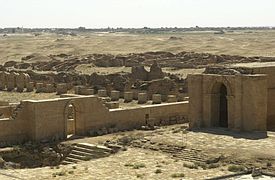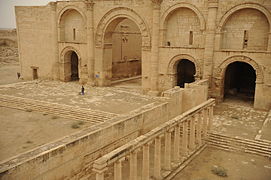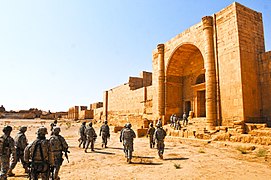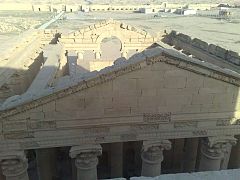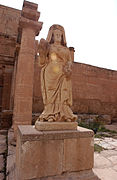Hatra
الحضر | |
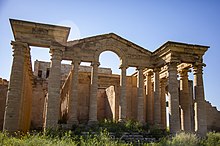 The ruins of Hatra in 2019 | |
| Alternative name | al-Ḥaḍr |
|---|---|
| Location | Hatra District, Nineveh Governorate, Iraq |
| Region | Mesopotamia |
| Coordinates | 35°35′17″N 42°43′6″E / 35.58806°N 42.71833°E |
| Type | Settlement, temple |
| Area | 300 ha (740 acres) |
| History | |
| Founded | 3rd or 2nd century BC |
| Abandoned | 241 AD |
| Cultures | Arab,[citation needed] Mesopotamian, Assyrian, Parthian |
| Satellite of | Parthian Empire |
| Site notes | |
| Condition | Ruins |
| Public access | Accessible |
Arab States | |
Hatra (
Hatra was a strongly fortified
Name
Hatra is known as al-Ḥaḍr (الحضر) in Arabic. It is recorded as 𐣧𐣨𐣣𐣠 (ḥṭrʾ, vocalized as: Ḥaṭrāʾ) in Hatran Aramaic inscriptions, probably meaning "enclosure, hedge, fence". In Syriac, it is usually recorded in the plural form Ḥaṭrē. In Roman works, it is recorded as Greek Átra and Latin Hatra and Hatris.[2]
The city was officially called Beit ʾElāhāʾ 𐣡𐣩𐣵 𐣠𐣫𐣤𐣠 "House of God", in Hatran Aramaic inscriptions[3] and once recorded as "Enclosure of Shamash" (ḥtrʾ d-šmš 𐣧𐣨𐣣𐣠 𐣣𐣴𐣬𐣴) on a coin.[2]
History
There is no archeological information on the city before the Parthian period but settlement in the area likely dates back to at least the


Hatra became an important fortified frontier city and played an important role in the
Hatra was the best preserved and most informative example of a
List of rulers
In inscriptions found at Hatra, several rulers are mentioned. Other rulers are sporadically mentioned by classical authors. The earlier rulers are titled mrjʾ (māryā, "lord") and the later ones mlkʾ d-ʿrb ("king of the Arabs"; malkā, "king").[2]
| Name | Title | Date | Portrait | Note | |
|---|---|---|---|---|---|
| 1 | Worod | mry´ | |||
| 2 | Ma’nu | mry´ | |||
| 3 | Elkud | mry´ | 155/156 | ||
| 4 | Nashrihab | mry´ | 128/29 – 137/38 AD | ||
| 5 | Naṣru | mry´ | 128/29 – 176/77 | ||
| 6 | Wolgash I
|
mry´ and mlk | The two brothers may have been co-rulers. | ||
| 7 | Sanatruq I | mry´ and mlk | 176/177 | ||
| 8 | Abdsamiya | mlk | 192/93 – 201/202 | Supported the Roman emperor Pescennius Niger | |
| 9 | Sanatruq II | mlk – King | 207/08 – 229/230 | Became a vassal of the Romans under Gordian III during Roman–Persian Wars | |
Art of Hatra
According to
-
Headless statue of a nobleman features intricate detail.
-
Military commander from the city of Hatra. Iraq Museum, Baghdad.
-
Limestone statue of a military commander in his uniform holding a statue of a deity.
-
Relief of the god Nergal from Hatra.
-
Hatra relief devotee.
Modern Hatra
Hatra was used as the setting for the opening scene in the 1973 film
The site was first surveyed by Walter Andrae of the German excavation team working in Assur from 1906 to 1911. But systematic excavations have been undertaken only from 1951 by Iraqi archeologists. From the 1980s, the Italian Archaeological Expedition,
In 2004, The Daily Telegraph stated "Hatra's finely preserved columns and statues make it one of the most impressive of Iraq's archaeological sites"[17]
Restoration by Saddam Hussein
Destruction by ISIL
Actions by the
UNESCO and
The pro-Iraqi government Popular Mobilization Forces captured the city on 26 April 2017.[27] A spokeswoman for the militias stated that ISIL had destroyed the sculptures and engraved images of the site, but its walls and towers were still standing though contained holes and scratches received from ISIL bullets. PMF units also stated that the group had mined the site's eastern gates, thus temporarily preventing any assessment of damage by archaeologists.[28] It was reported on 1 May that the site had suffered less damage than feared earlier. A journalist of EFE had earlier reported finding many destroyed statues, burnt buildings as well as signs of looting. Layla Salih, head of antiquities for Nineveh Governorate, stated that most of the buildings were intact and the destruction didn't compare with that of other archaeological sites of Iraq. A PMF commander also stated that the damage was relatively minor.[29]
Gallery
-
Remains of several temples and ancient walls (2004)
-
Elevated view of the site in 2007
-
Temple facade (May 2006)
-
Southern exposure of the temple (May 2006)
-
July 2008
-
Marn Temple (November 2008)
-
November 2008
-
American soldiers at the site, September 2010
-
American soldiers at the site, September 2010
-
Elevated view of the temple (September 2014)
-
Detail of a temple, showing Hellenistic, Mesopotamian and Iranian architecture
-
Decorated arch with faces
-
View of iwans
-
Closeup of an iwan
-
Facade of Temple
-
Arch of the temple
-
Protruded head on a wall
-
Statue of the Goddess Shahiro
-
From left to right, an unidentified ruler, Hermes, a female deity, and Sanatruq I.From Hatra. Erbil Civilization Museum
-
Door lintel from Hatra. 2nd-3rd century AD. Sulaymaniyah Museum, Iraqi Kurdistan
Climate
Hatra has a
| Climate data for Hatra (Al Hadar) | |||||||||||||
|---|---|---|---|---|---|---|---|---|---|---|---|---|---|
| Month | Jan | Feb | Mar | Apr | May | Jun | Jul | Aug | Sep | Oct | Nov | Dec | Year |
| Mean daily maximum °C (°F) | 12.8 (55.0) |
15.8 (60.4) |
19.8 (67.6) |
25.3 (77.5) |
33.0 (91.4) |
39.0 (102.2) |
42.3 (108.1) |
42.1 (107.8) |
37.9 (100.2) |
31.0 (87.8) |
22.5 (72.5) |
14.8 (58.6) |
28.0 (82.4) |
| Mean daily minimum °C (°F) | 3.2 (37.8) |
4.6 (40.3) |
7.6 (45.7) |
11.7 (53.1) |
17.3 (63.1) |
21.8 (71.2) |
24.8 (76.6) |
24.1 (75.4) |
19.7 (67.5) |
14.3 (57.7) |
8.8 (47.8) |
4.1 (39.4) |
13.5 (56.3) |
| Average precipitation mm (inches) | 43 (1.7) |
39 (1.5) |
49 (1.9) |
36 (1.4) |
13 (0.5) |
0 (0) |
0 (0) |
0 (0) |
0 (0) |
8 (0.3) |
25 (1.0) |
44 (1.7) |
257 (10.1) |
| Source: climate-data | |||||||||||||
See also
- Aramaic of Hatra
- Destruction of cultural heritage by ISIL
- Taq-i Kisra, sharing architectural features with structures at Hatra
References
- ISBN 978-3-515-10507-1. Retrieved 2023-09-29.
- ^ Encyclopaedia Iranica. Retrieved 16 March 2019.
- ^ "Hatra | ancient city, Iraq". Encyclopedia Britannica. Retrieved 2020-12-25.
- ^ a b c "Hatra". Encyclopædia Britannica. Retrieved 14 December 2013.
- ^ a b Advisory Body Evaluation on Hatra. International Council on Monuments and Sites (ICOMOS). 1985. pages 1–2.
- ISBN 9789004082656.
- ISBN 9789004162402.
- ^ "Hatra UNESCO World Heritage Centre". whc.unesco.org/en. UNESCO. 1992–2015. Retrieved 31 March 2015.
- ^ a b c Rosenfield, John M. (1967). The Dynastic Arts of the Kushans. University of California Press. pp. 170–173.
- ^ Freeman, Colin s (25 June 2014). "Iraq's 'Exorcist' temple falls into Isis jihadist hand". The Telegraph. London. Retrieved 7 March 2015.
- ^ "Hatra". whc.unesco.org. UNESCO. Retrieved 7 March 2015.
- ^ Hatra – Italian Archaeological Expedition
- ^ "L'Edificio A". Hatra – Italian Archaeological Expedition (in Italian). 2016-11-25. Retrieved 2020-07-25.
- ^ "I sondaggi del Temenos". Hatra – Italian Archaeological Expedition (in Italian). 2016-11-25. Retrieved 2020-07-25.
- ^ "Progetti/ Projects". Hatra – Italian Archaeological Expedition (in Italian). 2016-12-10. Retrieved 2020-07-25.
- ^ Gawlikowski, Michał (1991). "The first season of excavations in Hatra, Iraq" (PDF). Polish Archaeology in the Mediterranean. 2.
- ^ Freeman, Colin (4 January 2004). "American troops launch 'Exorcist' tour at ancient temple". The Telegraph.
- ISBN 9780226729435.
- Defense Video & Imagery Distribution System. 9 September 2006.
- ^ Cockburn, Patrick (27 February 2015). "Iraq: Isis militants pledged to destroy remaining archaeological treasures in Nimrud". The Independent. Archived from the original on 2022-05-09. Retrieved 8 March 2015.
- ^ "ISIL video shows destruction of 7th century artifacts". aljazeera.com. 26 February 2015. Retrieved 7 March 2015.
- ^ Karim Abou Merhi (5 March 2015). "IS 'bulldozed' ancient Assyrian city of Nimrud, Iraq says". AFP. Retrieved 5 March 2015.
- ^ Yacoub, Sameer N. (7 March 2015). "IS destroying another ancient archaeological site in Iraq". Army Times. United States. Associated Press. Retrieved 7 March 2015.
- ^ "Islamic state 'demolish' ancient Hatra site in Iraq". BBC. 29 September 2022. Retrieved 7 March 2015.
- ^ Vivian Salama (4 Apr 2015). "Video: Islamic State group shot, hammered away Iraq's Hatra". Associated Press.
- The Telegraph. Macon, Georgia. Archived from the originalon 10 March 2015. Retrieved 8 March 2015.
- ^ "Iraqi forces retake damaged Hatra heritage site from IS". Deutsche Welle. 26 April 2017. Retrieved 29 April 2017.
- ^ Hussain, Rikar (27 April 2017). "Iraqi Militias Find Relics Destroyed by IS in Ancient Town". Voice of America. Retrieved 29 April 2017.
- ^ "Hatra: IS damage to ancient Iraqi city less than feared". BBC News. 1 May 2017. Retrieved 1 May 2017.
Further reading
- al-Salihi, W. (2021). "Hatra: Three Notes, Historical, Iconographical, and Religious". Iraq. 83: 3–12. S2CID 239871840.
External links
- Between Rome and Parthia: The Desert City of Hatra
- http://lexicorient.com/e.o/hathra.htm Archived 2006-07-27 at the Wayback Machine
- http://www.britannica.com/eb/article-9039509
- http://shezaf.net/english/Video/Video/Hatra.html Archived 2011-07-16 at the Wayback Machine
- http://www.bbc.co.uk/archive/chronicle/8612.shtml BBC Chronicle"Lost Kings of the Desert"
- https://hatrasite.com/ Italian Archaeological Expedition at Hatra
- Iraqi forces seize ancient UNESCO site of Hatra from Islamic State as jihadis execute Mosul civilians









